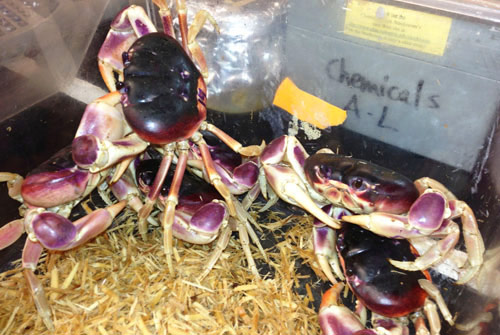Hormonal Control of Molting

Molting in decapod crustaceans is controlled by the X-organ (XO)/sinus gland complex, a neurosecretory center in the eyestalks (ES). The complex secretes a neuropeptide, molt-inhibiting hormone (MIH), that suppresses production of molting hormone (ecdysone), an ecdysteroid secreted by a pair of molting glands (Y-organs or YOs) located in the anterior of the body. In addition to MIH, other inhibitory factors, as well as changes in YO sensitivity to those factors, are involved in regulating YO activity. Inhibition of molting by certain environmental stressors (e.g., hypoxia, extremes in salinity and temperature) appears to be mediated by crustacean hyperglycemic hormone (CHH), a neuropeptide synthesized in the XO and other regions of the nervous system and gut. Both MIH and CHH inhibit YO ecdysteroidogenesis via binding to distinct membrane receptors. In land crab, Gecarcinus lateralis, regenerating limb buds produce a MIH-like peptide. During premolt, YOs are refractory to MIH and CHH, which is correlated with increased phosphodiesterase (PDE) activity. 20-Hydroxyecdysone (20E) inhibits YO activity, which may contribute to the rapid drop in hemolymph ecdysteroids just before ecdysis. These data indicate that the YO is a dynamic tissue responsive to changing hormonal conditions. It is the integration of the hormonal environment that ultimately determines YO activity and, consequently, when the animal molts.
The overall goal of this project is to understand how MIH and CHH regulate YO ecdysteroidogenesis. We cloned and characterized a calmodulin (CaM)-dependent NO synthase (NOS) and three guanylyl cyclases (β subunit of soluble NO-sensitive GC-I, membrane receptor GC-II, and soluble NO-insensitive GC-III) that are expressed in the YO. cDNAs encoding land crab MIH and CHH were characterized and biologically active recombinant neuropeptides were expressed in yeast. The data indicate that MIH signaling is organized into two phases, designated “triggering” and “summation”, which are mediated by cAMP/Ca2+ and NO/cGMP, respectively. CaM, a Ca2+-binding protein, plays a pivotal role in our model. It suppresses the triggering phase by activating a CaM-dependent cAMP/cGMP PDE (PDE1). CaM initiates the summation phase by activating NOS directly and indirectly through binding to calcineurin, which activates NOS by dephosphorylation. In contrast, we hypothesize that the CHH signaling pathway is mediated by a membrane receptor GC. Thus, both neuropeptides inhibit ecdysteroidgenesis by increasing cGMP, but through distinct pathways. A CaM-independent cGMP PDE (PDE5) counters the effects of both neuropeptides. The experiments use a comparative approach on G. lateralis and European green crab, Carcinus maenas. The aims are: (1) determine whether the MIH and CHH signaling pathways converge on cGMP-dependent protein kinase (PKG); (2) determine the effects of molt induction on YO response to rMIH and rCHH; and (3) determine the effects of ecdysteroid on YO signaling.
Understanding the hormonal regulation of decapod molting and growth is essential to manage fisheries involving native and invasive species, develop effective aquacultural practices, mitigate potential effects of pollutants (e.g., endocrine disruptors), and predict the consequences of environmental changes. Despite intense effort there is still no consensus on YO signaling mechanism(s). The identity of the MIH receptor remains unknown. Now that methods to express large amounts of active rMIH and rCHH are available, we can separately target the MIH and CHH signaling pathways. The organization of MIH signaling into two phases linked by CaM integrates a large body of work on various decapod species into a coherent and unified model.
Research
- Background
- Molting Gland Transcriptome Project
- Molt-induced Muscle Atrophy
- Hormonal Control of Molting
